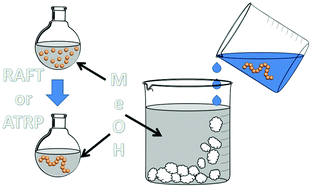Exploring the homogeneous controlled radical polymerisation of hydrophobic monomers in anti-solvents for their polymers: RAFT and ATRP of various alkyl methacrylates in anhydrous methanol to high conversion and low dispersity†
Abstract
In previous reports, the use of anhydrous methanol in the homogeneous ATRP polymerisation of n-butyl methacrylate (nBuMA) was shown to yield polymers with dispersities as low as Đ = 1.02, despite methanol being widely regarded as an anti-solvent for p(nBuMA). Herein, we describe the homogeneous methanolic controlled radical polymerisation of three hydrophobic alkyl methacrylate monomers (methyl, t-butyl and n-butyl methacrylate) using both ATRP and RAFT to generate a range of homopolymers, statistical copolymers, amphiliphilic block copolymers and branched polymers. Methanolic ATRP and RAFT are compared, with RAFT able to target high degrees of polymerisation (800 monomer units) with very low dispersities (Đ = 1.06) in shorter reaction times (44 h) under these conditions. Poly(ethylene glycol)-derived macroinitiators were shown to generate well defined A–B and A–B–A block copolymers (Đ = 1.02–1.18) whilst branched A–B block copolymers with weight average molecular weights up to Mw = 2.33 × 106 g mol−1 were readily synthesised. The role of methanol within the polymerisations is discussed.

- This article is part of the themed collection: David Sherrington Commemorative Issue


 Please wait while we load your content...
Please wait while we load your content...